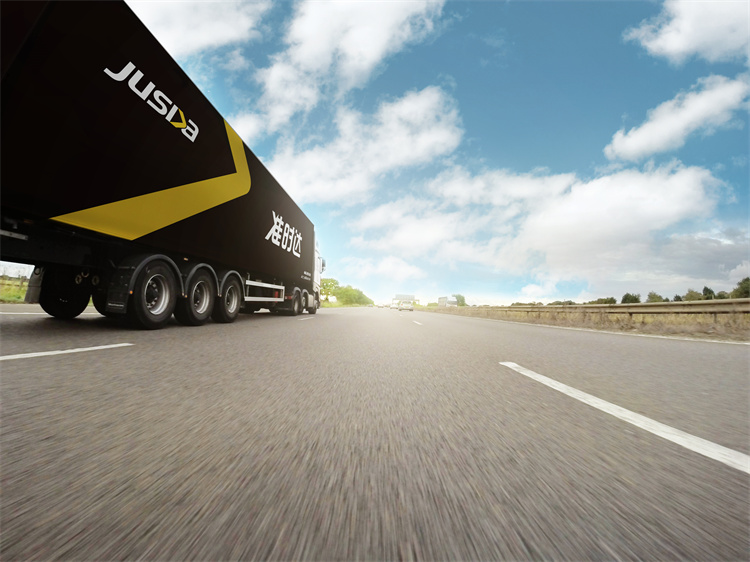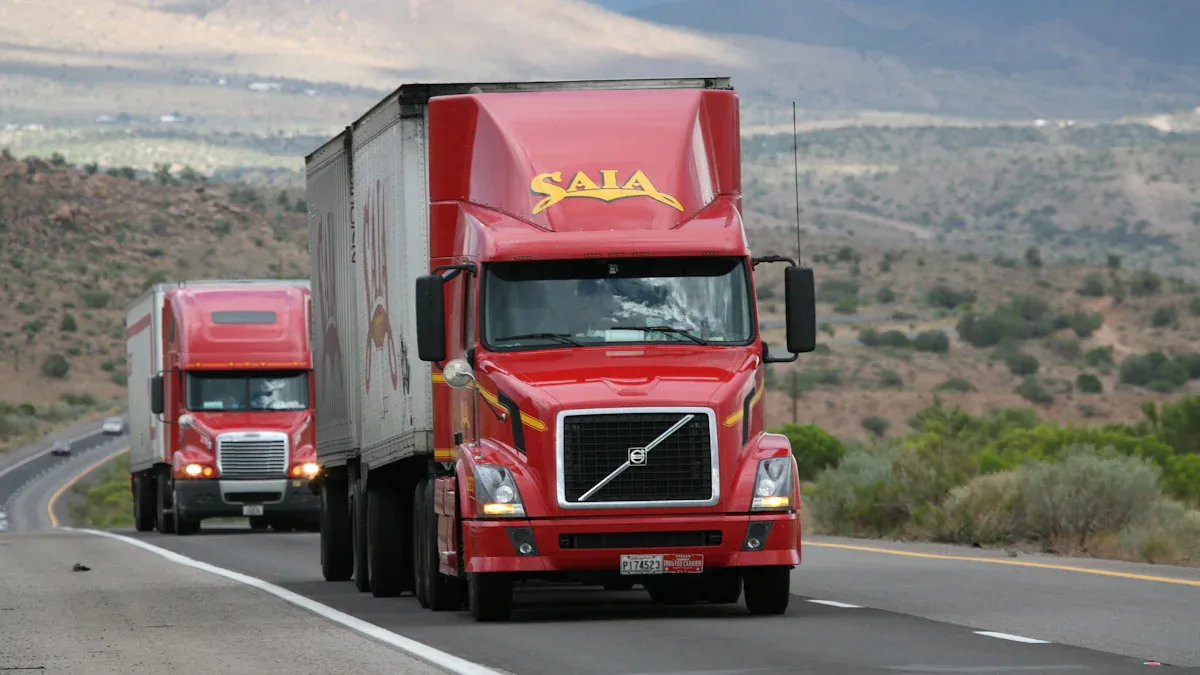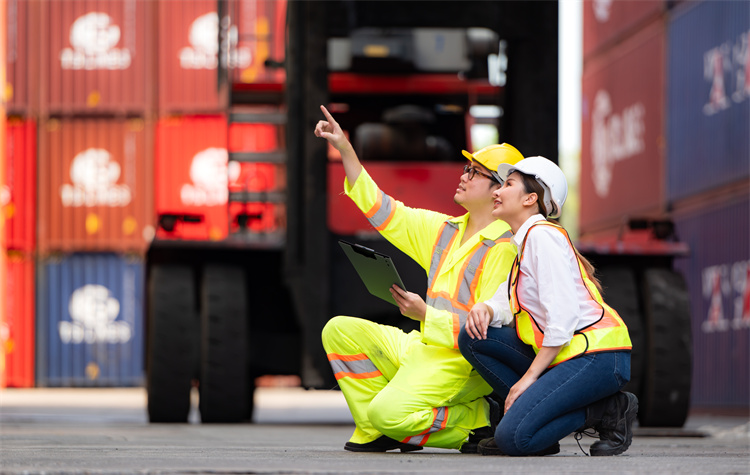Key Market Dynamics and Growth Predictions for Land Transport in 2025

The land transportation market in 2025 will undergo remarkable changes, driven by technological advancements and sustainability efforts. Key trends include the rapid adoption of electric and autonomous vehicles and the expansion of public transit systems.
Recent studies reveal that 77% of Americans view public transit as central to a multi-modal lifestyle, integrating ride-hailing, bikesharing, and autonomous technologies.
The global road haulage market is projected to grow at a CAGR of over 6%.
Spain will lead Europe’s growth with an 8.10% CAGR by 2025.
Freight transport in the U.S. will expand, with 70% of projects operational by 2025.
These dynamics highlight the transportation outlook and land transport predicting market dynamics growth 2025.
Key Takeaways
The land transport market will grow a lot by 2025. This is because of electric and self-driving vehicles.
Public transit is very important now. About 77% of Americans want it in daily life.
Governments are giving rewards for buying electric cars. This makes them cheaper and helps the environment.
More people are moving to cities, so better transport is needed. Smart ideas like electric buses and fast trains are helping.
New technology like AI and IoT is improving transport. It makes travel safer and more efficient.
Growth Predictions for Land Transport in 2025

Regional Growth Trends in Land Transport
North America: Electrification and Infrastructure Modernization
North America is expected to lead in electrification and infrastructure development. The U.S. freight industry will see significant investments in electric trucks and charging networks. These advancements will reduce the environmental impact of freight demand while improving transportation access. Infrastructure modernization projects, such as smart highways and urban transit systems, will enhance accessibility and efficiency. The region's focus on clean transportation solutions aligns with sustainability initiatives, driving growth in the transport services market.
Europe: Sustainability Leadership and Policy-Driven Growth
Europe will maintain its position as a leader in sustainability initiatives. Spain, with a projected CAGR of 8.10% by 2025, exemplifies the region's commitment to green policies. Investments in autonomous vehicles and electric vehicle growth will dominate the market. Governments will continue to enforce stringent emission standards, encouraging the adoption of clean technologies. These efforts will shape key transportation industry trends, ensuring Europe remains at the forefront of sustainable transport.
Asia-Pacific: Urbanization and Emerging Market Potential
Asia-Pacific will experience rapid growth due to urbanization and infrastructure development. Countries like China and India will invest heavily in transport services markets to meet rising freight demand. The region's e-commerce boom will drive freight market dynamics, particularly in last-mile delivery. Urban centers will adopt autonomous vehicles to address congestion and improve transportation access. These developments highlight the region's potential to influence global land transport predicting market dynamics growth 2025.
Sector-Specific Growth Forecasts
Freight Market Dynamics: E-commerce and Last-Mile Delivery Expansion
The global last-mile delivery market is projected to grow at a CAGR of 8.13% from 2022 to 2031. The U.S. freight industry will benefit from increased e-commerce activity, with retail sales surpassing $1 trillion in 2022. Freight supply and demand will rise as businesses prioritize faster delivery times. Asia-Pacific will lead this growth, with China accounting for nearly 50% of global e-commerce transactions. These trends will redefine freight market dynamics, emphasizing efficiency and accessibility.
Public Transportation Outlook: Investments in Rail and Bus Networks
Public transportation systems will see substantial investments in rail and bus networks. Governments will prioritize infrastructure development to support urbanization and reduce environmental impact. High-speed rail projects and electric buses will dominate clean transportation solutions. These initiatives will enhance transportation access, making public transit a cornerstone of sustainable urban mobility.
Investment Trends in Land Transport
Private Sector Investments in Technology and Innovation
Private companies will play a crucial role in advancing land transport. Investments in autonomous vehicles and electric trucks will drive innovation. These technologies will improve freight demand management and reduce costs. The transport services market will benefit from enhanced efficiency and sustainability.
Public-Private Partnerships for Infrastructure Development
Collaboration between public and private sectors will accelerate infrastructure development. Governments will fund large-scale projects, while private firms will introduce cutting-edge technologies. Public-private partnerships will ensure balanced growth, addressing both freight supply and demand. This approach will support land transport predicting market dynamics growth 2025.
Key Influencing Factors in Land Transport Predicting Market Dynamics Growth 2025
Economic Conditions and Their Impact
Global Economic Growth and Its Influence on Land Transport
Economic growth plays a pivotal role in shaping land transport dynamics. Expanding economies drive increased freight activity, boosting demand for efficient transportation systems. The global road haulage market is projected to grow at a CAGR of over 6%, while the U.S. road freight transport market is expected to achieve a CAGR of 3.75% from 2024 to 2030. Spain leads Europe with a remarkable CAGR of 8.10% between 2020 and 2025.
Table: Economic Growth and Freight Market Projections
Description
Projected Growth Rate
Worldwide ton-kilometers (2019-2050)
Nearly double under ITF's Current Ambition scenario
Global road haulage market CAGR
Over 6% during the forecast period
US road freight transport market CAGR
3.75% from 2024 to 2030
Spain's projected CAGR (2020-2025)
8.10%
These figures highlight the strong correlation between economic expansion and the transportation sector's growth.
Fuel Prices and Their Role in Shaping Freight Market Dynamics
Fluctuating fuel prices significantly impact freight costs and market dynamics. Rising prices for marine gas oil (MGO) and very low sulfur fuel oil (VLSFO) are expected to increase freight rates by 3.5% and 4.3%, respectively, in 2025. Conversely, biofuels like B100 may see a price reduction of 4.2%, offering a more sustainable and cost-effective alternative.
Fuel price trends influence route costs and operational decisions, making them a critical factor in freight market planning.
Technological Innovations Driving Growth
Role of AI, IoT, and Big Data in Transportation Outlook
Technological advancements like AI, IoT, and Big Data are transforming land transport. Predictive analytics enables accurate demand forecasting, while IoT facilitates real-time data collection for optimized routing and vehicle monitoring. These innovations enhance efficiency and reliability, addressing urbanization-driven challenges.
Key Applications of AI, IoT, and Big Data
Predictive analytics for supply-demand forecasting.
Data-driven route planning to reduce congestion.
Real-time vehicle health monitoring for fleet management.
These technologies not only improve operational efficiency but also support decarbonization efforts by reducing fuel consumption and emissions.
Advancements in Battery Technology and Renewable Energy
Battery technology advancements are accelerating the adoption of electric vehicles (EVs). Improved energy density and faster charging capabilities make EVs more viable for freight and passenger transport. Renewable energy integration further supports decarbonization, reducing reliance on fossil fuels. These innovations align with global sustainability goals, driving the transport sector's growth.
Sustainability and Environmental Concerns
Push for Carbon Neutrality in Land Transport
The transport sector accounts for nearly one-quarter of global energy-related CO2 emissions, with road travel contributing 75%. Decarbonization efforts focus on transitioning to zero-emission vehicles and adopting efficiency technologies. The International Transport Forum projects that effective policies could reduce freight emissions by 72% and urban passenger transport emissions by 80% by 2050.
Impact of Climate Change on Transportation Policies
Climate change influences transportation policies, prompting governments to prioritize sustainable infrastructure. Tools like Virginia's SMART Scale evaluate projects based on environmental impact, ensuring alignment with decarbonization goals. These measures drive innovation and investment in clean transportation solutions.
Infrastructure Development and Its Role
Expansion of Road and Rail Networks
Expanding road and rail networks plays a vital role in meeting the growing demands of urbanization and economic activity. Governments and private sectors are prioritizing projects that enhance connectivity and reduce congestion. The roads and highways segment is expected to dominate the market, accounting for over 50% of the share in 2023. This growth reflects the increasing need for new roads and highways due to rising population density and economic development.
Urban rail networks are also undergoing significant upgrades to reduce transport emissions and pollutants. Large cities are integrating transport and land use planning to ensure sustainable growth. Land value capture has emerged as a key financing initiative, allowing developers to benefit from increased property values near transit hubs. Feasibility studies and public transit upgrade plans further support these efforts.
Note: Railways and metro systems are projected to grow steadily as countries expand their public transport lines. These developments highlight the importance of infrastructure in shaping sustainable and efficient transportation systems.
Innovations in High-Speed Rail and Hyperloop Technologies
High-speed rail and hyperloop technologies represent the future of transportation. High-speed rail systems offer faster travel times and reduced environmental impact compared to traditional railways. Countries like China and Japan have already established extensive high-speed rail networks, setting benchmarks for efficiency and innovation.
Hyperloop technology, still in its developmental phase, promises revolutionary changes in land transport. This system uses magnetic levitation and low-pressure tubes to achieve speeds exceeding 600 miles per hour. Hyperloop projects aim to connect major cities, reducing travel times and enhancing regional connectivity. These advancements align with global sustainability goals by minimizing carbon emissions and energy consumption.
Callout: The combination of high-speed rail and hyperloop technologies will redefine infrastructure development, offering faster, cleaner, and more efficient transportation solutions.
JUSDA’s Role in Shaping the Future of Land Transport
JUSDA’s Supply Chain Innovations
JusLink Intelligent Supply Chain and Its Impact on Freight Market Dynamics
JUSDA’s JusLink platform revolutionizes supply chain management by leveraging advanced technologies like IoT, AI, and big data. The platform provides real-time visibility into freight operations, enabling businesses to optimize delivery schedules and reduce costs. Features such as predictive analytics and route optimization enhance efficiency, addressing challenges like urban congestion and fluctuating demand.
Innovations like fleet tracking and GPS technology further improve operational efficiency. These tools allow businesses to monitor vehicle health and allocate resources effectively, ensuring timely deliveries. By integrating these technologies, JUSDA enhances the overall customer experience while driving advancements in freight market dynamics.

JUSDA Solutions
To provide you with professional solutions and quotations.
Industry-Specific Solutions for Optimized Land Transport
JUSDA tailors its services to meet the unique needs of various industries, including automotive, FMCG, and heavy equipment. For instance, its solutions for the electronics sector focus on minimizing transit times to preserve product quality. In the medical field, JUSDA ensures the safe and timely delivery of sensitive supplies. These industry-specific approaches highlight JUSDA’s commitment to providing customized logistics solutions that address diverse market demands.
The company’s focus on innovation and efficiency positions it as a leader in the land transport sector. By combining advanced technologies with tailored strategies, JUSDA continues to optimize global supply chains and support sustainable growth.
The land transportation market in 2025 will thrive on technological advancements, sustainability efforts, and regional growth. Stakeholders must adopt innovative solutions like JUSDA’s China-Europe Express Rail to remain competitive. Strategic partnerships will play a pivotal role in this evolution. For instance, collaborations such as Vitesco Technologies and DHL Supply Chain demonstrate how alliances enhance efficiency and sustainability. Governments, private companies, and consumers must work together to address challenges and foster innovation. This collective effort will ensure the sector meets the demands of a rapidly changing global economy.
FAQ
What are the key factors driving growth in the land transport market?
Technological advancements, sustainability initiatives, and urbanization drive growth. Increased demand for efficient freight solutions and public transportation systems also contributes. Governments and private sectors invest heavily in infrastructure and innovation to meet market needs.
How does JUSDA’s China-Europe Express Rail benefit businesses?
The service offers faster delivery than sea freight and lower costs than air freight. It ensures reliable transportation for various goods, including electronics and medical supplies. This solution supports businesses in optimizing supply chains and meeting growing demand.
Why is there a renewed focus on transportation accessibility?
Urbanization and environmental concerns highlight the need for accessible transportation. Efficient systems reduce congestion and emissions while improving mobility. Governments and private sectors collaborate to enhance infrastructure and ensure equitable access to transport services.
See Also
Get Prepared: Discovering New Transport Tech Innovations
Prepare Yourself for Transformative Transport Technology Changes
Analyzing the Upcoming Trends in LTL Freight Transportation
Enhancing Supply Chain Performance: Five Key Trends Ahead
Your Complete Handbook for Eco-Friendly Supply Chain Transport
